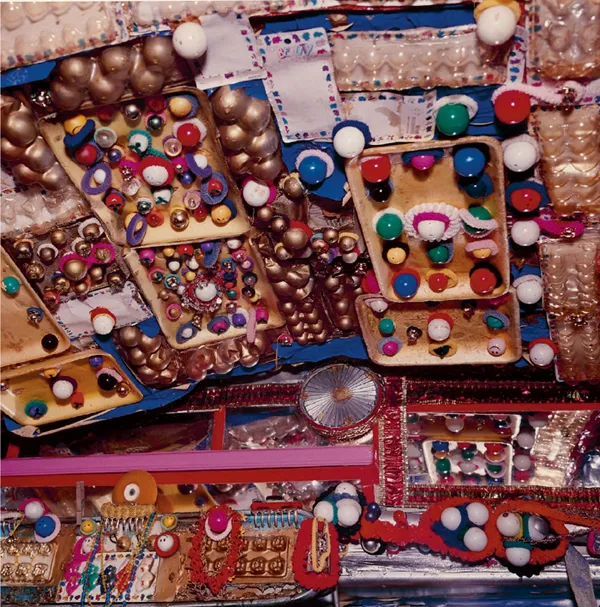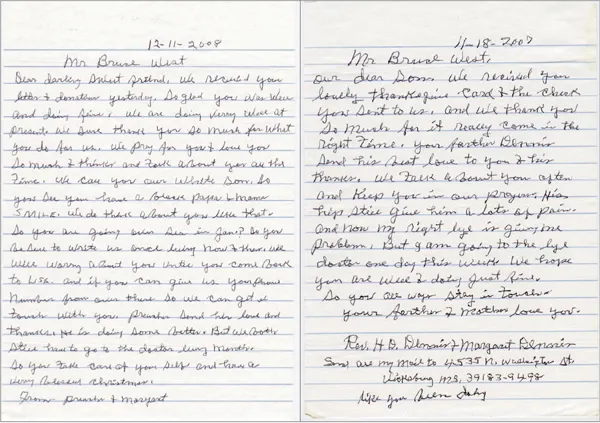![]()
VISITING THE REVEREND AND MARGARET
Bruce West
It is bright, hot, and steamy, even in the early morning hours. Kudzu covers the trees; everything seems thick and green. I pull off Business Route 61 in Vicksburg, Mississippi, and stand in front of a small one-story building that is elaborately decorated. There is an archway several feet in front of the main door, and there are towers, ten or twelve of them, some more than three stories tall, some still under construction. The building and towers are painted in bands of high-gloss red, white, blue, and green. One sign announces that this is Margaret’s Grocery, the Home of the Double Headed Eagle. Another sign tells me: “Welcome Jews and Gentiles. This Church Open 24 Hours A Day.” Other signs offer quotes from the Bible. I walk up to the front door. The front porch is festooned with Mardi Gras beads, bits of plastic flowers, and other items I can’t immediately identify. The frame around the front door is layered with ornate moldings painted a vibrant blue and yellow. Something tells me this visit could be a life-changing experience.
So, I rap on the door. Nothing. I try to peer through the screen door but cannot see a thing; it is very dark inside. Rap a little harder. I hear some motion, a shuffling of feet, and eventually a short, slightly stooped, and older woman answers the door. I offer my introduction and ask permission to photograph. She smiles beautifully, introduces herself as Margaret Dennis, and says I am welcome to photograph but suggests that I first speak to her husband, the Reverend. “The Reverend?” She points to her left and says, “Yes, Reverend Dennis, he is in the church.” I look in the direction she is pointing. I do not see a church. It looks like an old yellow school bus to me. I say, “The bus.” She says, “The church.” I say, “Oh yeah, the church!”
I walk in the direction indicated. Even though the door is open, I can feel the heat pouring out of the bus—I mean, the church. I rap hesitantly and an older, thin, and wiry man, with a dress shirt and tie, tells me to come in. In addition to his tie, there are some colorful beads and some sort of plastic lens hanging around his neck. The Reverend H. D. (Herman Dan) Dennis stands very straight and exudes a formal and imperious presence. A podium covered with a brightly colored cloth, a vase of plastic flowers, and the Reverend’s Bible stands where the driver’s seat should be. I quickly attempt to explain my presence. Before I can finish, the Reverend starts praying, blessing me, and thanking God for my coming here. He becomes very animated in his praying, and it seems to get even hotter in the church; we are both sweating. The Reverend has a unique and slightly high-pitched voice, a little difficult to decipher. I realize I will need to listen carefully. I note that the Reverend, even with his heavy-duty hearing aids, is quite hard of hearing. I yell my questions and responses to him.
After thanking him for his blessing, I ask Reverend Dennis for permission to photograph. He assures me I can photograph but that he should first discuss some of his “symbolism.” He walks me around the exterior of the old grocery store and explains that he is slowly transforming it, building the archway and towers to turn the little grocery store into a palace for his wife. He tells me that he had promised Margaret that he would do just this when he had asked her hand in marriage. A vision from God instructed him to woo Margaret and commence his work on the Grocery. The Reverend insists that the eastward orientation of the Grocery is auspicious, since all wisdom and knowledge comes from the East. He shows me the tallest tower designed to hold the Ark of the Covenant and the Ten Commandments and elaborates on the significance of various Masonic symbols. His explanations go on and on, for hours, meshing accounts about his own life, the retelling of numerous Bible stories, his understanding of ancient history, his assessment of current politics, and preaching for the betterment of all mankind. I am totally overwhelmed but try to be patient and polite, not wanting to interrupt the flow of the Reverend’s conversation by picking up my camera. Finally, with an incredulous look on his face, the Reverend stares at me and asks why I am not taking pictures. I suddenly realize he will never stop preaching and lecturing. I need to figure out a way to listen carefully to the Reverend, respond to his many questions and comments, and still make photographs.
I begin photographing the facade of the Grocery, the towers, and the bus. I ask the Reverend to pose for a few images. For one, he stands with his arms upraised on both sides of his body, assuring me that this is how Christ stood before Pilate. In another pose, he kneels down on one knee and peers upward through his hands that are configured to form an open triangle. This gesture is the way Elizabeth greeted the Virgin Mary when she arrived to announce her pregnancy. He seems to know all things.
The sun continues to beat down so the Reverend invites me inside the Grocery where it is darker and cooler. The front room of Margaret’s house that serves as the Grocery is illuminated with a few bare lightbulbs. A long counter with an antique cash register divides the room in half. Cans and jars of food items line the shelves behind the counter. On other shelves there are stacks of paper towels and toilet paper, plastic bins with potatoes and onions. The Grocery serves a limited clientele—folks from the immediate neighborhood and the occasional stranger pulling in for a cold bottle of Coke on a hot summer day. Most of the space in the Grocery is devoted to the display of the Reverend’s artistic creations. The Reverend instructs me to look up and I see that the ceiling of the Grocery is decorated with an elaborate tracery of brightly painted moldings. The moldings are inlaid with sparkling pieces of metal and accented with other items such as plastic Easter eggs, elastic hair ties, and bits of costume jewelry. To better illuminate his work, the Reverend plugs in numerous strings of multicolored flashing Christmas-tree lights.
The Reverend exhorts: “Look at my work. Look at it. It is absolutely perfect.” He then pulls out a large golden trunk. It is encrusted with mirrors, Mardi Gras beads, and various other baubles and is sealed with several locks and latches. “You know what this is?” demands the Reverend. “You read your Bible? Do you know the Good Book? This here is the Ark of the Covenant!” Inside the Ark, the two tablets of the Ten Commandments are cradled in thick cushioning, covered with lace and satin. The Reverend explains that the Vicksburg Police Department had discovered the Ten Commandments in the woods and had brought them to him for safekeeping. A cut-glass doorknob on the inside lid of the Ark serves as “the all-seeing eye.” A banner on a pole that attaches to the Ark proclaims, “The Devil is on the Run.” I notice another large sculptural piece vying for space with the groceries—a menorah-like structure topped with several candles and a profusion of plastic flowers. A sign on the menorah says, “Seven Churches,” referring to the seven churches of Asia Minor. There are many other objects of different sizes but the Reverend does not explain their significance. The Reverend admonishes me, “I can’t tell you everything because you can only understand so much.”
It is getting late in the day and the Reverend suggests that I leave before it gets dark. He walks me to my truck and salutes in strict military fashion as I drive off, a ritual he performs for each of his departi...



